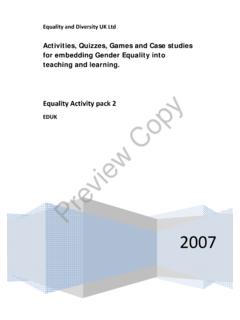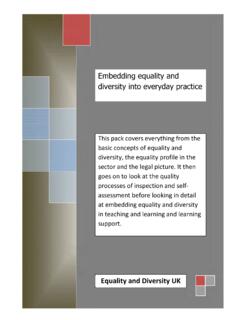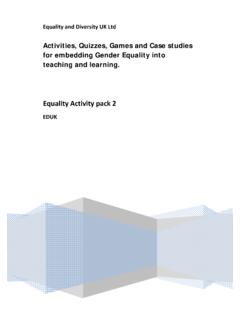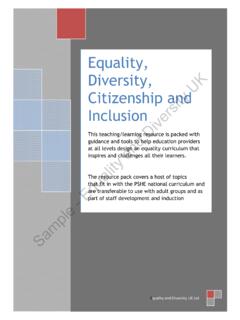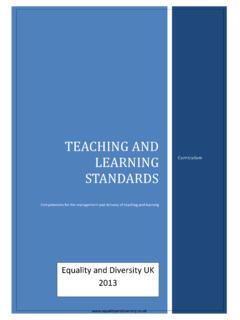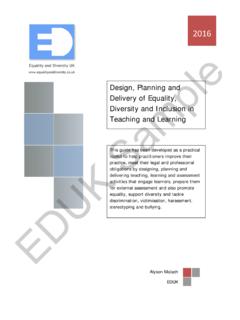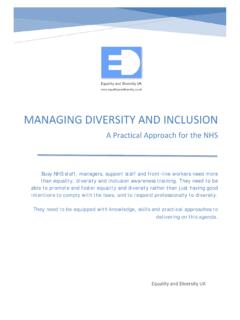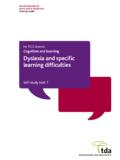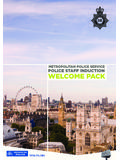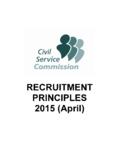Transcription of Six Strands of Equality and Diversity
1 Equality and Diversity UK Ltd 2008 Six Strands of Equalityand Diversity activity pack EDUK 2 Contents Introduction About the Activities 4 Introduction activity Descriptions 5 Introduction Where does Equality & Diversity fit in? 8 Introduction Working Ethos 12 Introduction What are the six Equality Strands ? 12 activity 1 Myth Busters Disability 13 activity 2 Equality Quiz All six Strands 15 activity 3 Perceptions: F Exercise All six Strands 23 activity 4 Diversity Champion All six Strands 26 activity 5 The Sociogram Exercise All six Strands 29 activity 6 Paradigm of Prejudice & Discrimination All six Strands 43 activity 7 Exploring Definitions All six Strands 52 activity 8 Detailed Quiz All six Strands 55 activity 9 Diversity Bingo All six Strands 61 activity 10 Heterosexuality Sexual Orientation 64 activity 11 Life Chances All six Strands 67 activity 12 Stereotypes Age 72 activity 13 Case Studies All six Strands 75 activity 14 Stopping Harassment Age 83 activity 15 Growing Up and Growing Older Age 85 activity 16 Similarities Between Old and Young Age 88 activity 17 Balloon Tag Religion 91 activity 18 Discussion Statements Religion 95 activity 19 The Complexities of Sexual
2 Orientation Sexual Orientation 100 activity 20 Drawing Conclusions Sexual Orientation 103 3 activity 21 The Girl With No Name Gender 105 activity 22 Social Roles Gender 108 activity 23 Female Action Heroes Gender 110 activity 24 Where s My Toy? Gender 112 activity 25 Looking at Languages Race 115 activity 26 Majority/Minority Relationships Race 117 activity 27 ChildLine Counsellors Race 120 activity 28 Visually Impaired Disability 124 activity 29 Hearing Impaired Disability 126 activity 30 Physically Challenged Disability 128 About the Activities These entertaining and thought provoking activities give participants the opportunity to experience life from a different viewpoint and/or discuss issues with those who may have suffered discrimination, unwitting or otherwise, at firsthand. This activity pack contains 30 practical tried and tested activities specifically aimed at engaging the 14-19 age group. Many are energetic and experiential, offering the participants powerful insights into key Equality and Diversity issues.
3 Each activity plan contains the following information: Equality strand The Equality and Diversity area(s) touched upon by the activity : Gender Sexual orientation Race Religion Age Disability Class Deprive communities Potential use Group sizes, potential for adaption to cover other issues Purpose The rationale behind the activity Learning outcomes How participants will be able to demonstrate the knowledge or skills they will have gained by completing the activity Key terms Words and phrases associated with Equality and Diversity issues that participants will have a deeper understanding of after completing the activity Resources The resources and preparation you need to do in advance of the activity Method A step by step guide to delivering the activity Variations How the activity may be delivered in different ways to meet different needs or limitations Handout, cards, answer sheets.
4 And supporting information A range of materials to support the activity 5 activity Descriptions activity 1 Myth Busters A true or false quiz enables participants to dispel popular misconceptions concerning mental illness. activity 2 Quiz Participants compete in teams to get the highest score in this 10 question quiz to test their knowledge of a range of Equality and Diversity issues. activity 3 Perceptions: F Exercise This lively icebreaker or short activity brings home the difference between treating people equally and treating them fairly. activity 4 Diversity Champion Participants work together to decide what attributes are needed in order to be a leader in championing Diversity and present their ideas in picture form. activity 5 The Sociogram Exercise This is a physical activity in which participants decide where they personally stand (literally) on a range on a range of viewpoints relating to any one or all six Equality Strands .
5 activity 6 Paradigm of Prejudice and Discrimination Participants decide how they would respond to a range of everyday scenarios and analyse their behaviour to reveal their own prejudices and discriminatory behaviour. activity 7 Exploring Definitions The importance of language in discussing Diversity is demonstrated as participants devise individual and group definitions of terms such as prejudice, discrimination, racism, sexism and homophobia. activity 8 Detailed Quiz This quiz reveals some startling facts that show discrimination is alive and well and living in our communities. activity 9 Diversity Bingo This is a fun and energising activity in which participants have to find people with the right skills and knowledge of Diversity in everyday life and popular culture in order to win the game. activity 10 Heterosexuality This activity promotes understanding of the prejudices commonly encountered by gays and lesbians by turning the tables and subjecting heterosexuals to similar prejudices.
6 activity 11 Life Chances Participants take part in a physical activity that shows in a simple but effective way how some young people's options are limited by family background, racism, sexism, discrimination against disabled people and those who are lesbian or gay. 6 activity 12 Stereotypes Using older people as an example, this activity brings home to participants how we all carry stereotype images in our heads and automatically draw on them without thinking. activity 13 Case Studies Participants have to use tact, diplomacy and assertive behaviour in order to maintain good working relationships whilst applying their learning to real life situations. activity 14 Stopping Harassment This activity provides participants with a range of strategies and techniques for challenging and combating harassment in the form of teasing and bullying. activity 15 Growing Up and Growing Older By reviewing a range of statements and comparing their answers, participants identify common stereotypes applied to young people, older people or both.
7 activity 16 Similarities between Old and Young Participants examine their own stereotypes about older people by considering older adults in their lives and the many similarities between the lives of teenagers and the lives of older people. activity 17 Balloon Tag A high energy game of Tag leads on to a question and answer matching activity that helps to expand the participants knowledge about world religions. activity 18 Discussion Statements Participants analyse their own religious beliefs and/or values before debating issues concerning the impact of religion on modern life for individuals and society. activity 19 the Complexities of Sexual Orientation Categorising a range of people based on descriptions of their preferences, experience and how they see themselves leads participants to realise that there is more to people s sexual orientation than simply labelling them as heterosexual , lesbian , gay or bisexual activity 20 Drawing Conclusions This is a group activity in which participants draw images to represent gay, lesbian, bisexual, transgender and straight people before questioning the validity of these images.
8 activity 21 the Girl with No Name Hearing about the deep-rooted feelings and experiences of one transgender person in the quest to establish their true identity helps participants to empathise and recognise how they can offer support to transgender people. 7 activity 22 Social Roles This activity employs a self-reflective process in which participants write and share short pieces about how their gender identities were affected through childhood messages about what it meant to be a boy or a girl. activity 23 Female Action Heroes After viewing excerpts from children s television programmes, the participants compare the female action heroes to their male counterparts and discuss whether these gender stereotypes influence the attitudes or behaviour of boys and girls. activity 24 Where s My Toy? Participants consider how the toys we play with as children can reinforce gender stereotypes and attempt to choose gender-neutral gifts for the first ten years of a child s life.
9 activity 25 Looking at Languages Pictorial prompts help participants to consider the range of languages spoken in today s schools and the impressive achievement of young people who have to switch between languages in order to function in different areas of their lives. activity 26 Majority/Minority Relationships This activity allows participants to experience being part of a majority group and being in a minority group and, in relation to ethnic groups, to think about the strategies we may use to break in and out of groups we form. activity 27 ChildLine Counsellors Participants develop strategies for dealing with racist abuse by assuming the role of ChildLine counsellors advising young people who are victims of such abuse. activity 28 Visually Impaired Gaining firsthand experience of carrying out a simple task with a visual impairment brings home to participants some of the problems experienced by visually impaired people in daily life and sets them thinking about adjustments that can be made to make things easier.
10 activity 29 Hearing Impaired Participants experience for themselves how hard it can be to communicate with other when you have a hearing impairment and work out what adjustments could be made to make day to day tasks easier. activity 30 Physically Challenged Participants face a physical challenge that demonstrates how hard simple tasks can be when you do not have full use of your limbs and they consider the adjustments that can be made to help physically impaired people cope with ordinary Where does Equality and Diversity fit in? Schools have a duty to promote Equality of opportunity for all students and staff, regardless of their gender, sexual orientation, race, religion or disability. Equality should be embedded in school policies on equal opportunities, behaviour and the curriculum. Understanding and respect for Diversity and differences are important aspects of many areas of school life and learning. In particular, recognising the effects of bullying, stereotyping, prejudice and discrimination of any kind, and helping young people to develop the skills to challenge discrimination assertively are key elements.
